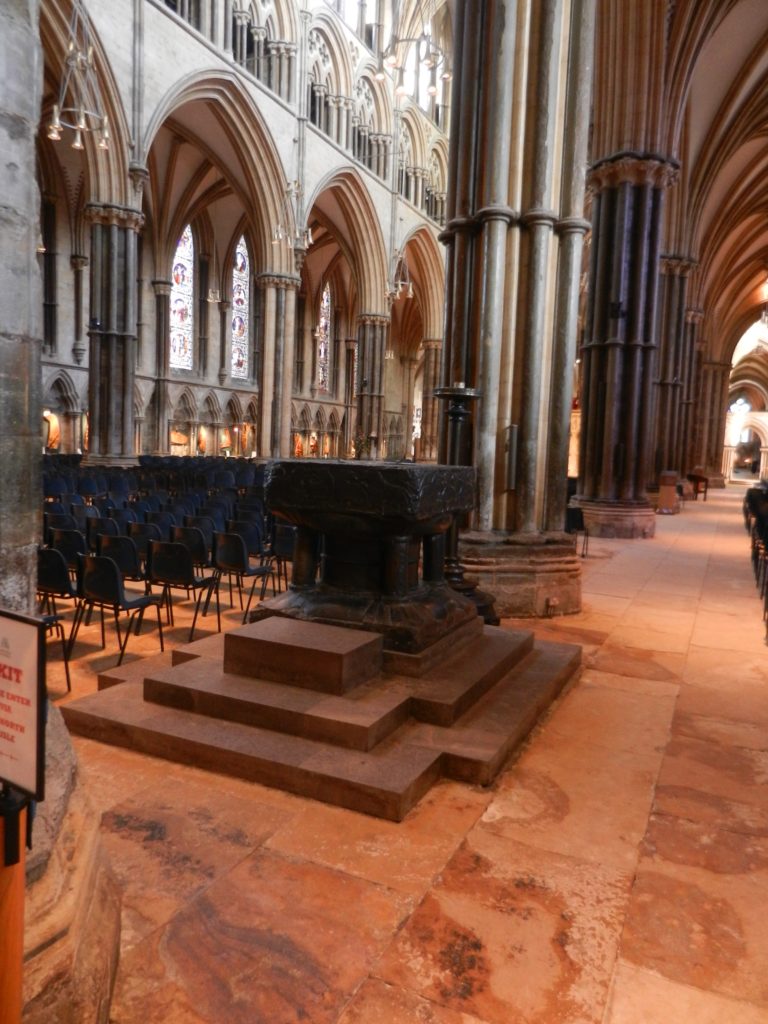
A photo of Lincoln Cathedral’s Tournai marble font, one of only four (I think) in England made from this rock, one of the others being in the rural parish church at Thornton Curtis, between Goxhill and Wooton in North Lincolnshire.
The mention of Sheffield cathedral prompted me to return to this topic for this one blog/post.
As a consequence of Augustine’s missionary visit to south-east England (then the Anglo-Saxon kingdom of Kent) in the late 6th century a church building in Canterbury was given the status of cathedral, this after the conversion of the Kentish king, becoming the seat of the Southern Archbishop and Primate of England. To affirm the rise of Christianity in Anglo-Saxon England seven further churches were built as cathedrals, each with their regional sees, these being Durham, Lichfield, London (the original St. Paul’s), Rochester, Winchester (the sometime capital town), Worcester and York (the original Minster). Little remains now of the Anglo-Saxon church fabric.
The second wave of cathedral building was a big part of the Norman church building/rebuilding programme which transformed townscapes in England. Chichester, Lincoln, Salisbury (Old Sarum site) and Norwich cathedrals were all completed between 1066 and 1100, Ely soon following in 1109 and Exeter a few years later (this on the site of a previous minster Anglo-Saxon church). The Norman cathedral church at Bath was superseded by that at Wells in1244, while Carlisle Norman church was the last of England’s pre-Reformation cathedrals.
The Reformation in England included the third wave of cathedral building/designation in England. Here all five newly designated cathedrals, Bristol, Chester, Gloucester, Oxford and Peterborough, had been monastic churches, now de-monked by the legislation of the reign of Henry VIII.
The fourth wave of cathedral building/designation was in the 19th century between 1836 and 1884. Here the story was one of parish churches being elevated to cathedral status and the creation of new sees, this being true of Ripon, Manchester, St. Albans, Newcastle. Southwell and Wakefield. The two new-builds were at Truro and Liverpool (begun 1880, the building programme not completed until well into the 20th century).
The final era of cathedral building/designation was in the 20th century between 1905 and 1927. Here the only new-build was at Guildford, the other 11 being parish churches of various architectural styles elevated to the status of cathedral. Of the 11 five pre-date the Great War, Southwark, Birmingham, Bury St. Edmunds, Chelmsford and Sheffield, while Coventry, Bradford, Blackburn, Leicester, Derby and Portsmouth were re-classified in the inter-War years.
The overview then is one of successive fragmentation of previous sees, this to achieve greater contact between Church and people or to achieve greater control, this depending on the historical context. The process by which an existing building is re-designated as a cathedral is simple, a new chair is added somewhere inside, Not, of course, any old chair, but the Bishop’s Chair, this a symbol of the new status, not just somewhere for him (or her) to take a rest. The fragmentation of sees has not been without its anomalies, witness the situation in the Howden area of East Yorkshire. Another anomaly can be found in Kingston upon Hull which has a bishop but no cathedral. It could be argued that Minster status is halfway there – but that’s a story for another day.